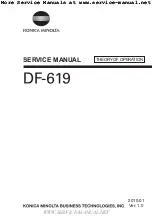
16
THE CUTTERS WILL AUTOMATICALLY CLAMP
ON START UP. IN ORDER TO ENSURE THAT
THEY ARE CORRECTLY SEATED THICKNESS A
300 OR 410mm WIDE PIECE OF TIMBER
INTENSIVELY ACROSS THE FULL CUTTING
SURFACE.
8.0 Preparation of the Workpiece
In preparation for all processes, examine the workpiece carefully for faults that may affect the
machining process, particularly foreign bodies such as nails, staples etc. There are many
different kinds of timber, with many different working characteristics. A skilful wood machinist
must consider the grain direction, the shape of the timber, whether it is bowed or twisted, and
the positions of defects such as knots, wavy edges etc. He should also consider any other
peculiar characteristics of the material, such as salicaceous or calceous deposits, which could
cause severe blunting and chipping of the cutters. If a number of abrasive pieces are to be
planed, use the ends of the cutter rather than the middle if possible.
8.1 Pilot Checks
Details on the correct setting of the guards, fence etc., together with the use of the necessary
safety devices, are detailed in the following sections of this manual. Prior to operation however
the following checks should be carried out (first isolate machine):
1.
The blades are not cracked or distorted.
2.
The cutterblock runs free (check by slowly turning it by hand).
3.
The cutterblock guards are secure.
4.
The timber is free of grit, nails or other foreign bodies.
5.
The tables are free of spanners, rules etc., and that all tools are returned to their rightful
place.
9.0 Surface Planing
Caution: Ensure that all stock is clear of the blades before start-up.
When surfacing, the depth of cut is set by adjusting the height of the infeed table, using the
Surface Table Rise and Fall Handle.
Unlock the Surface Table Rise and Fall Lock prior to making any adjustment, and re-tighten once
set.
The outfeed table is already set level with the cutting circle of the cutterblock.
The sawn finish and the straightness of the timber determine the amount of cut required.
For
normal working it is good practice to set the amount of cut to 1.5mm.
When planing rough
sawn or bowed timber the amount of cut can be increased to 3mm, so as to obtain a clean finish
with one pass over the cutters.
The timber should be fed in with consideration to the grain direction. The following illustration
shows how timber fed through the cutters against the grain will cause it to tear out, producing a
















































